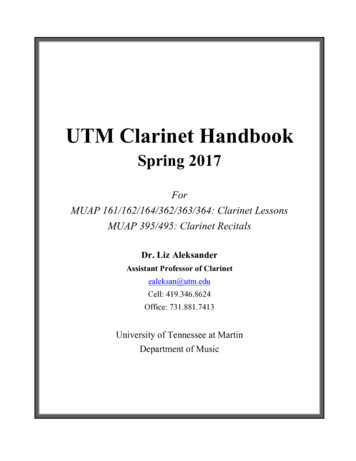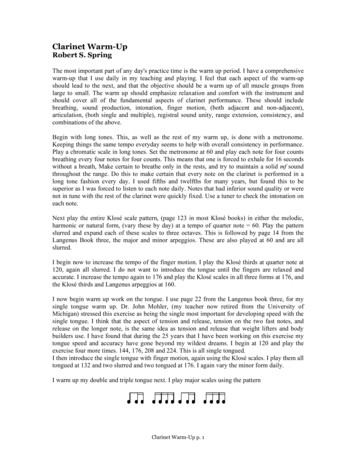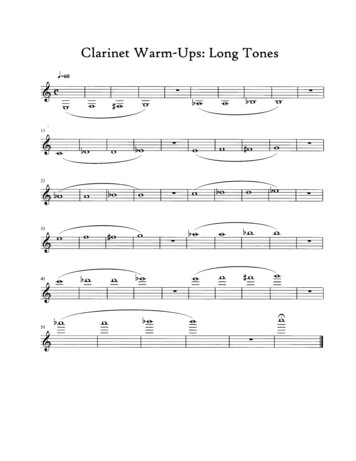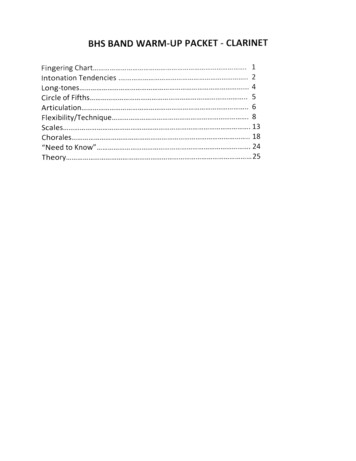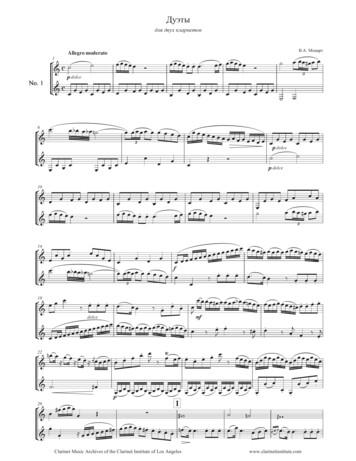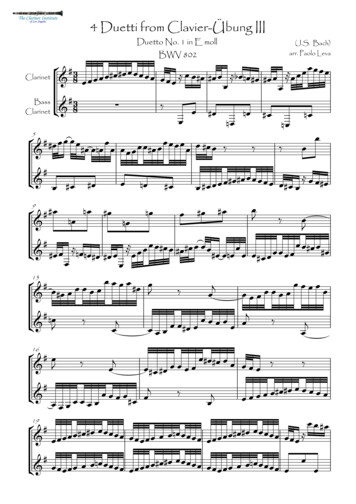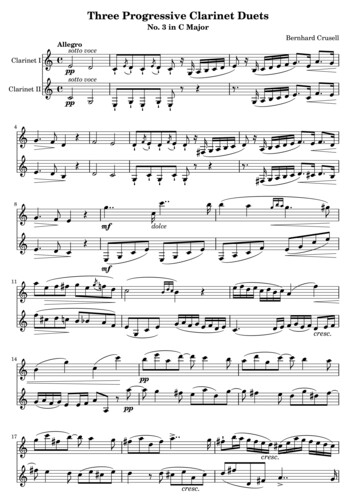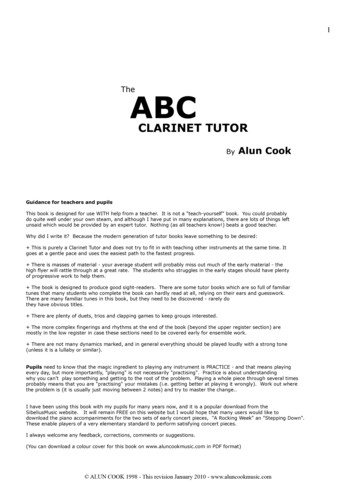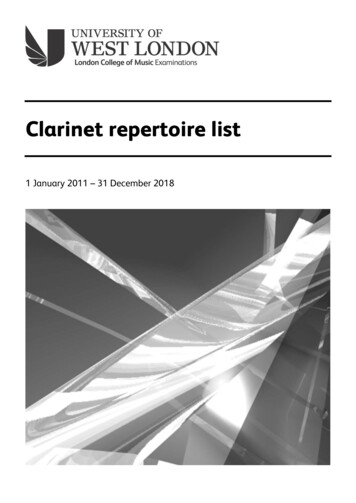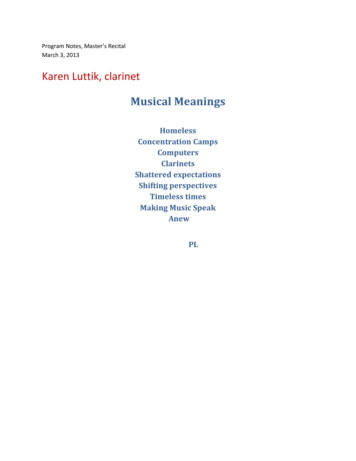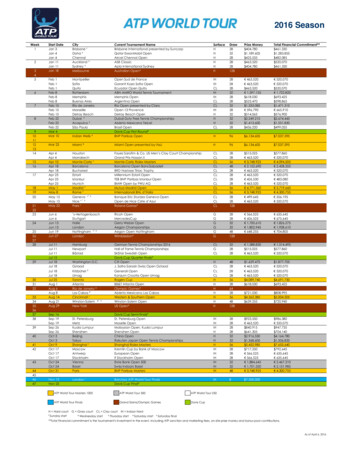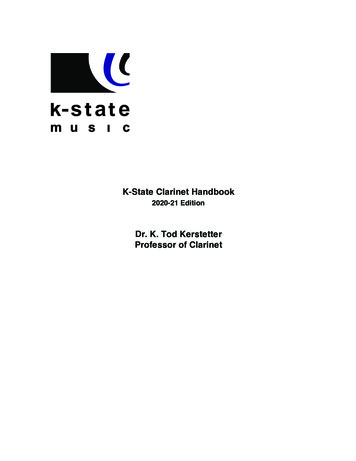
Transcription
K-State Clarinet Handbook2020-21 Edition2016-17 EditionDr. K. Tod KerstetterProfessor of Clarinet
KSU Clarinet HandbookTable of ContentsApplied Clarinet Syllabus . . . . . . . . . . . . . . . . . . . . . . . . . . . . . . . . . . . . . . . . . . . .2Applied Clarinet Level Guidelines . . . . . . . . . . . . . . . . . . . . . . . . . . . . . . . . . . . . . . . 4Recommended Clarinet Discography . . . . . . . . . . . . . . . . . . . . . . . . . . . . . . . . . . . . 7Recommended Clarinet Equipment . . . . . . . . . . . . . . . . . . . . . . . . . . . . . . . . . . . . . 9Individual Student Syllabus Form . . . . . . . . . . . . . . . . . . . . . . . . . . . . . . . . . . . . . . . 11Lesson Grading Guidelines . . . . . . . . . . . . . . . . . . . . . . . . . . . . . . . . . . . . . . . . . . . 12Semester Juries Information . . . . . . . . . . . . . . . . . . . . . . . . . . . . . . . . . . . . . . . . . . . 13Technical Worksheets(Break-crossing segments, two-octave major and melodic minor scales,full-range major and minor scales, major arpeggios, minor arpeggios, scales in thirds,chromatic scales, diminished and augmented arpeggios, whole tone scales) . . . . . . . . . . . . . . . 14Warm-up Patterns . . . . . . . . . . . . . . . . . . . . . . . . . . . . . . . . . . . . . . . . . . . . . . . . . . . . . 35Crossing the Break on Clarinet . . . . . . . . . . . . . . . . . . . . . . . . . . . . . . . . . . . . . . . . 38Resonance Fingerings for Clarinet . . . . . . . . . . . . . . . . . . . . . . . . . . . . . . . . . . . . . 39Crossing the Break on Clarinet, Part II . . . . . . . . . . . . . . . . . . . . . . . . . . . . . . . . . . 41Tuning the Clarinet . . . . . . . . . . . . . . . . . . . . . . . . . . . . . . . . . . . . . . . . . . . . . . . . . 42Alternate Fingerings for the Clarinet . . . . . . . . . . . . . . . . . . . . . . . . . . . . . . . . . . . . 43Breaking In New Reeds . . . . . . . . . . . . . . . . . . . . . . . . . . . . . . . . . . . . . . . . . . . . . . 45Metronome Practice Techniques . . . . . . . . . . . . . . . . . . . . . . . . . . . . . . . . . . . . . . . 46Phrasing: How Do You Practice It? . . . . . . . . . . . . . . . . . . . . . . . . . . . . . . . . . . . . . 47Articulation Styles Used on the Clarinet . . . . . . . . . . . . . . . . . . . . . . . . . . . . . . . . . . 48Recommended Books about Playing the Clarinet . . . . . . . . . . . . . . . . . . . . . . . . . . 50
Kansas State UniversityApplied Clarinet SyllabusCourse Nos. MUS 251, 254, 255, 455Professor: Dr. K. Tod KerstetterÏ General PoliciesPlease let me know in advance if you cannot attend your weekly lesson. The best way is to emailme, contact me on social media, or leave a message on my door. Excused lessons will be madeup whenever possible. Lessons canceled at the last minute, or after the time for which the lessonwas scheduled, will be rescheduled at Dr. Kerstetter’s discretion.Ï Required Supplies music (I will always help you find a way to obtain it) KSU Clarinet Handbook:Available online at ethandbook.pdf metronome, or metronome an adequate supply of playable reedsNote — Just like books for any other class at KSU, reeds, and music are required materials.You must have them in order to progress as a clarinetist. Funding for these necessary suppliesmust be planned and budgeted.An accompanist is required for the jury examination if the solo work you have prepared has apiano part. Faculty accompanist Amanda Arrington will be available for approximately 50% ofthe studio each semester. Dr. Kerstetter will make these assignments, generally based on thedifficulty of the accompaniment.Ï Grading2020-21 Update: With the possibility of spreading COVID-19, the strategy will be differentthis year. The clarinet with its open tone holes has been demonstrated to be a very strongspreader of aerosols, and we therefore need to take added precautions. Some events will bein-person, but likely many will happen virtually over Zoom or other methods such assubmitting performance videos. At the time I am updating this handbook, the situation issomewhat fluid as to how I will structure my grading rubric. It will depend on theuniversity’s policies as the situation continues to develop.Lessons will normally be graded, and a carbon copy of the lesson grade and comments will begiven to the student. Bear in mind that your own level of playing in relation to your coursenumber, combined with the amount you improve over the course of the semester, are the factorsthat are considered.
KSU Clarinet Handbook 3Studio Seminars are held on Thursdays at 11:30 in Room 324, which should be already reservedon your schedule for MUS 050 (Recital Attendance). Wind and Percussion Divisional recitalsoccur about once a month on Tuesdays at 11:30 in Kirmser Hall (Room 204). Attendance formusic majors is required, unless you have a conflict of which I am aware. I will give a list of allrequired clarinet studio events at our first studio meeting. In addition to studio seminars anddivisional recitals, there will faculty, guest, and student recitals that you will need to attend,typically numbering around 4 to 5 events per semester. Attendance of these events is required,as they are significant for your musical development. It is also good etiquette to support theother members of the studio and artists who are visiting. Marching band sectionals, pepband assignments, or fraternity/sorority meetings do not excuse you. If you plan far enoughahead you, should be able to work around these issues.Ï Grading Rubric for Music MajorsWeekly Lesson Grades — 40 pointsEvent Attendance (1 point for each studio seminar, divisional recital, etc) — 20 pointsScales Recording Project — 10 pointsEtude Recording Project — 10 pointsJury Grade (assigned by me, including other faculty members’ opinions)— 20 pointsNon-music majors will just have the weekly lesson and jury components—60 points total.Ï Etude Recording ProjectEach student will select, with consultation from Dr. Kerstetter, an etude to record during thesemester. The goal is to obtain a musical result that reflects thorough practice, attention to detail,and personal pride. The final project should be emailed to Dr. Kerstetter as an mp3 file. I willdiscuss this project further in studio seminar.Ï Technical Items (scales, arpeggios, etc.)There are certain technical items that must be mastered at each level. These items must bepracticed every day. They will normally be heard at your lesson each week. The philosophy is asimple one: a higher degree of technical proficiency will allow the student to perform moreliterature, with the ultimate goal of becoming a better musician. Note: All scales and other technical items must be played from memory for juries.Ï LevelsThere are certain guidelines and standards that are necessary for a student to pass from course tocourse. This is considered at the jury every semester. Please consult the guidelines page forbenchmark literature and etudes for the differing levels of applied courses.Ï Practice TimeWhile the actual time it takes to master certain techniques or certain pieces varies greatly fromplayer to player, the suggested amount of daily practice time is 2 hours for principals, 1 hour fornon-majors, and 3 hours for performance majors. This includes practice time for warm-up, fingertechnique, etudes, and literature as well as music for your ensembles.Ï Office HoursI maintain an open-door policy (even when the door is actually closed!), except when I amteaching a lesson. Please feel free to come by at any time if you have questions or need help ofsome kind.
KSU Clarinet Handbook 4Kansas State UniversityApplied Clarinet Level Guidelines(These guidelines only reflect a general sense of how a collegiate clarinetist should be progressing.Every studentʼs actual program of study will differ—goals will be set at the beginning of each semester.)Freshman Level! EtudesHite Melodious and Progressive Studies, Vol. 1Rose 32 Etudes and 40 StudiesThurston Passage Studies, Vol. 1! TechniqueMusic Education and B.A. majorsAll major scales (2 octave all slurred, sixteenths @ a quarter 60, E, F, F#, and G 3 octave)Chromatic scale from low E to high G# (3 1/3 octaves)Performance majorsAll full-range major and minor scales, full rangeChromatic scales, starting on four different notes! Sample of Solo RepertoireConcert and Contest CollectionFinzi Five BagatellesStamitz Concerto in BbSaint-Saëns Sonata, 1st and 2nd mvts.Weber Concertino! EtudesRose 32 Etudes and 40 StudiesPolatschek Advanced StudiesThurston Passage Studies, Vol.2! TechniqueMusic Education and B.A. majorsMajor scales as aboveAll melodic minor scales, 2 octavesChromatic scale as abovePerformance majorsAll full-range major and minor scalesAll major and minor arpeggiosAll major scales in thirdsChromatic scalesSophomore Level
KSU Clarinet Handbook 5(Sophomore Level)! Sample of Solo RepertoireArnold SonatinaBrahms SonatasHindemith SonataOsborne RhapsodySaint-Saëns Sonata (all mvts.)Schumann Fantasy Pieces! EtudesJunior Level(Rose as needed)Polatschek Advanced StudiesThurston, Vol. 2Orchestral excerpts! TechniqueMusic Education and B.A. majorsFull-range major scalesMinor scales 2 octaves, or (opt.) full-rangeMajor and minor arpeggiosChromatic scaleScales in thirdsPerformance majorsFull-range major and minor scalesMajor and minor arpeggiosChromatic scalesScales in thirds! Sample of Solo RepertoireLutoslawski Dance PreludesMozart Concerto, 1st and 3rd Mvts.Poulenc SonataRossini Introduction, Theme, and VariationsSpohr ConcertosTartini/Jacobs ConcertinoWeber Concertos
KSU Clarinet Handbook 6! EtudesSenior Level and abovePolatschek Advanced StudiesThurston, Vol. 3Uhl 48 StudiesOrchestral excerpts! TechniqueFull-range major and minor scalesMajor and minor arpeggiosChromatic scalesScales in thirdsAugmented and diminished arpeggiosWhole tone scales! Sample of Solo RepertoireDebussy Première RhapsodieKovács HommagesMartino A Set for ClarinetMartinu SonataNielsen ConcertoStravinsky 3 Pieces (unaccompanied)Sutermeister Capriccio (unaccompanied)
KSU Clarinet Handbook 7Selected Clarinet DiscographyIt is extremely important to listen to as many professional clarinetists as you can. While youcertainly will not like every aspect of a clarinetist’s performing, the experience of listening willallow you to develop and sharpen your concept of clarinet sound. It is particularly interesting tocompare different performers playing the same work. In the area of earlier works for clarinet,you will notice that the articulations will vary greatly! There are hundreds of recordings of theMozart Concerto on the market. Buy several, and decide on your favorite!Here are some picks to get you started. While many of these CD’s are very difficult to find inrecord stores at the mall, they are available at many internet sites.! James Campbell (Canadian solo artist, currently on the faculty of Indiana University)Brahms: Horn Trio and Clarinet TrioChandos 8606! Jonathan Cohler (American solo artist)The Clarinet Alone (Martino A Set for Clarinet, Persichetti Parable, Osborne Rhapsody, otherworks by Wellesz, Messiaen, William O. Smith, and Paganini)Ongaku Records 024-105! Eddie Daniels (American solo artist, both jazz and classical styles)Brahms and Weber Quintets, with The Composers String QuartetThis is my favorite recording of the Weber Quintet—phenomenal!Beautiful LoveThis is a terrific introduction to Daniels’ jazz playing, if you don’t know it already!! Stanley Drucker (retired principal clarinetist, The New York Philharmonic)John Corigliano: Concerto for Clarinet, Samuel Barber: Third Essay for OrchestraNew World Records NW 309-2The Corigliano Concerto is an extraordinarily difficult work—perfect for Drucker’s mindboggling technique!! Sharon Kam (Israeli solo artist)Clarinet Concertos (by Mozart and Krommer)Teldec 3984-21462-2This young Israeli artist possesses a gorgeous sound, and plays very energetic interpretations ofthese two warhorses of the clarinet repertoire.! Paul Meyer (French solo artist)French Clarinet Art (Debussy Première Rhapsody, sonatas by Saint-Saëns, Poulenc, Honegger,other works by Chausson and Milhaud)Denon CO-79282Twentieth-Century Music for Unaccompanied Clarinet (Stravinsky Three Pieces, BoulezDomaines, Stockhausen In Freundschaft, other works by Berio, Jolivet and Messiaen)Denon CO-78917
KSU Clarinet Handbook 8! Sabine Meyer (former principal, Berliner Philharmoniker, German solo artist)Clarinet Connection: The Great Concertos (concertos by Mozart, Weber and Stamitz)The Mozart concerto is performed on a “basset clarinet” (as the concerto was originally written)with a range down to low C.Johann & Carl Stamitz Clarinet Concertos(Three concertos by Carl Stamitz, one by Johann Stamitz)EMI Classics 7-54842-2This is a sparkling recording of some of the earliest solo works for clarinet. Listen for the waythat she uses ornamentation to make these works sound fresh even to our modern ears!! Ricardo Morales (Principal Clarinetist, Philadelphia Orchestra)French PortraitsBoston Records BR1064CD! David Shifrin (American solo artist)A Brahms/Schumann Soirée (Schumann Fantasiestücke, 2 Brahms Sonatas)Delos DE 3025Brahms: String Quintet in G, Clarinet QuintetDelos DE 3066Mozart: Clarinet Concerto, Clarinet QuintetD/CD 3020As on Sabine Meyer’s CD, the Mozart is performed on a “basset clarinet.”! Robert Spring (clarinet professor at Arizona State University)Dragon’s TongueFlight of the Bumblebee played double-tongued with circular breathing—are you kidding me?!Joan Tower: Music for Clarinet (includes Clarinet Concerto and Wings, other works)Summit Records DCD 124! Richard Stoltzman (American solo artist)Messiaen: Quartet for the End of TimeRCA Victor 7835-2-RGThis is a phenomenal recording of this twentieth-century masterpiece, performed by the chamberensemble “Tashi.” Stoltzman is a very prolific artist, with man
The clarinet with its open tone holes has been demonstrated to be a very strong spreader of aerosols, and we therefore need to take added precautions. Some events will be in-person, but likely many will happen virtually over Zoom or other methods such as submitting performance videos. At the time I am updating this handbook, the situation is somewhat fluid as to how I will structure my grading .
